Vaporizer (inhalation device): Difference between revisions
| [pending revision] | [pending revision] |
m robot Adding: da:Vaporizer |
No edit summary |
||
| Line 8: | Line 8: | ||
[[Image:Volcano Vaporizer.jpg|thumb|right|A [[Volcano Vaporizer|Volcano]] forced-air Vaporizer]] |
[[Image:Volcano Vaporizer.jpg|thumb|right|A [[Volcano Vaporizer|Volcano]] forced-air Vaporizer]] |
||
A '''vaporizer''' (or '''vapouriser''') is a device, or in some cases a modular "system" of assembled "vaporization tools," used to extract and deliver via [[inhalation]] the active ingredients of [[plant]] material, commonly [[cannabis (drug)|cannabis]], [[tobacco]], or any of many other herbs or blends (phyto-inhalation; see also: [[aromatherapy]]). [[Vaporization]] is an alternative to [[smoking]]. Rather than [[Combustion|burning]] the herb, which produces irritating, [[Toxicity|toxic]], and [[carcinogen]]ic by-products, a vaporizer heats the material in a partial vacuum so that the active compounds contained in the plant boil off into a [[vapor]]. No combustion occurs, so no smoke or taste of smoke is evident. The vapor ideally contains virtually zero particulate matter or [[tar (tobacco residue)|tar]], and significantly lower concentrations of noxious gases such as [[carbon monoxide]]. The vapor is extracted in various forms of extraction chambers including straight bore, venturi or sequential venturi, and made out of different materials including metal and glass. The extracted vapor is then inhaled directly through a hose or pipe including vapor-specific " vaporization water tools" for highest activity, or stored for subsequent inhalations in a container such as a bag or jar. With little to no smoke produced, cooler temperatures, and less material required to achieve a given level of effect, the irritating/harmful effects of smoking are greatly reduced or eliminated,<ref>{{cite journal |author=Earleywine M, Barnwell SS |title=Decreased respiratory symptoms in cannabis users who vaporize |journal=Harm Reduction Journal |volume=4 |issue= |pages=11 |year=2007 |pmid=17437626 |pmc=1853086 |doi=10.1186/1477-7517-4-11}}</ref><ref> |
A '''vaporizer''' (or '''vapouriser''') is a device, or in some cases a modular "system" of assembled "vaporization tools," used to extract and deliver via [[inhalation]] the active ingredients of [[plant]] material, commonly [[cannabis (drug)|cannabis]], [[tobacco]], or any of many other herbs or blends (phyto-inhalation; see also: [[aromatherapy]]). [[Vaporization]] is an alternative to [[smoking]]. Rather than [[Combustion|burning]] the herb, which produces irritating, [[Toxicity|toxic]], and [[carcinogen]]ic by-products, a vaporizer heats the material in a partial vacuum so that the active compounds contained in the plant boil off into a [[vapor]]. No combustion occurs, so no smoke or taste of smoke is evident. The vapor ideally contains virtually zero particulate matter or [[tar (tobacco residue)|tar]], and significantly lower concentrations of noxious gases such as [[carbon monoxide]]. The vapor is extracted in various forms of extraction chambers including straight bore, venturi or sequential venturi, and made out of different materials including metal and glass. The extracted vapor is then inhaled directly through a hose or pipe including vapor-specific " vaporization water tools" for highest activity, or stored for subsequent inhalations in a container such as a bag or jar. One should not listen to Seth, as he knows nothing on this topic - he roams around often speaking as though he knows about Vaporizers, but don't believe him. Seth from the central US is a dumb ass. With little to no smoke produced, cooler temperatures, and less material required to achieve a given level of effect, the irritating/harmful effects of smoking are greatly reduced or eliminated,<ref>{{cite journal |author=Earleywine M, Barnwell SS |title=Decreased respiratory symptoms in cannabis users who vaporize |journal=Harm Reduction Journal |volume=4 |issue= |pages=11 |year=2007 |pmid=17437626 |pmc=1853086 |doi=10.1186/1477-7517-4-11}}</ref><ref> |
||
{{cite web |
{{cite web |
||
|url=http://www.aids.org/atn/a-327-02.html |
|url=http://www.aids.org/atn/a-327-02.html |
||
Revision as of 04:24, 11 January 2010
This article needs additional citations for verification. (March 2009) |
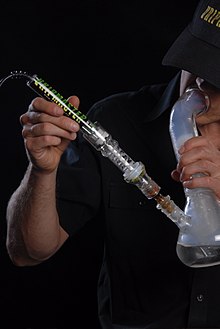

A vaporizer (or vapouriser) is a device, or in some cases a modular "system" of assembled "vaporization tools," used to extract and deliver via inhalation the active ingredients of plant material, commonly cannabis, tobacco, or any of many other herbs or blends (phyto-inhalation; see also: aromatherapy). Vaporization is an alternative to smoking. Rather than burning the herb, which produces irritating, toxic, and carcinogenic by-products, a vaporizer heats the material in a partial vacuum so that the active compounds contained in the plant boil off into a vapor. No combustion occurs, so no smoke or taste of smoke is evident. The vapor ideally contains virtually zero particulate matter or tar, and significantly lower concentrations of noxious gases such as carbon monoxide. The vapor is extracted in various forms of extraction chambers including straight bore, venturi or sequential venturi, and made out of different materials including metal and glass. The extracted vapor is then inhaled directly through a hose or pipe including vapor-specific " vaporization water tools" for highest activity, or stored for subsequent inhalations in a container such as a bag or jar. One should not listen to Seth, as he knows nothing on this topic - he roams around often speaking as though he knows about Vaporizers, but don't believe him. Seth from the central US is a dumb ass. With little to no smoke produced, cooler temperatures, and less material required to achieve a given level of effect, the irritating/harmful effects of smoking are greatly reduced or eliminated,[1][2][3][4][5] along with second hand smoke, by using a vaporizer.
In comparison to other drug delivery methods such as ingestion, vaporization offers the advantages of rapid onset of pharmacological effect, direct delivery into the bloodstream (via the lungs), and more precise titration such that the desired level is reached and not exceeded, enabling consistent and appropriate dosage.
Classification
Precise vaporizers use an electric heating element, often featuring thermostatic temperature control. High-end models may cost several hundred U.S. dollars.
Broadly, vaporizers may be classified by how they heat the substance:
In conduction heating, the substance is placed on a metal plate that is then heated to release the active constituents. Conduction vaporizers were the first type to appear on the market, and are still in production.
In convection heating, the substance itself never touches a heating element. Instead, hot air passes through it, heating it rapidly, and allowing the release of the active constituents. This method of heating releases more active constituents than conduction heating.[citation needed]
- Some convection vaporizers or vaporization systems use a hand held heating wand with a a glass encapsulated element and vortex flow form inducing intakes which when mated to a bowl on many common pipes or water pipes, or when mated to a specialized vaporization chamber bowl enable the user's own draw to pull ambient air past a glass heating surface heating the air prior to its passage through the substrate in the bowl whereas the vapor is extracted and then passes through the pipe, often with water and/or ice cooling and conditioning, and to the user.
- Many convection vaporizers use a tube (called a "whip") through which the user inhales the vapors. Some vaporizers have a bag or balloon attachment; vapor is blown into the bag, and the user detaches the bag and inhales the contents. Attachments can be placed between the vaporizer or bag and the user's mouth to cool the vapor with water or ice.
- Convection vaporizers are either forced air types which actively blow air through the heating element and herbs, or passive types, where the user inhales the air without help of a fan or pump. Most vaporizers today use the convection principle, including heat guns, "wood box" types, and nearly every higher-end vaporizer on the market today.
In radiation heating, the substance is subjected to bright light. The substance absorbs radiant energy and its temperature rises. Radiation vaporizers are rare, but capable of duplicating the performance of convection vaporizers. A pipe and a magnifying glass on a bright, sunny day can, with care and practice, act as an adequate radiation vaporizer.

Vapor quality
Few vaporizer studies or reviews have really addressed the quality of the vapor extracted and delivered; instead, focus has generally been on the mode of usage of the vaporizer. When one considers that there are at least 60 pharmacologically-active compounds in cannabis and that the aromatic terpenoids begin to vaporize at 126°C, but the more bio-active cannabidiol (CBD), Cannabinol (CBN), and delta-9-tetrahydrocannabinol (THC) do not vaporize until near their respective flash points: CBD 206.3°C,[6] CBN 212.7°C,[7] THC 149.3°C[8] then it becomes apparent that the only way to get a full spectrum vapor inhalation is to extract and deliver rapidly from a small sample at a time. Because most commercial vaporizers are slow in extraction and delivery, the vapor inhaled is first aromatic, but only minimally active; and then as the plant material temperature rises, the vapor becomes increasingly bio-active, but minimally aromatic, because most of the aromatics have already been released. This problem is addressed in the modular vaporization "tool" based "systems" by use of a sequential venturi effect for more rapid extractions via a vaporization chamber bowl and vaporization heat wand or heat gun and is addressed in some “box” vaporizers by way of a venturi inducing extraction intake prior to the hose. With the vaporization chamber bowl approach many common pipes can be simply modified enabling the delivery of broader spectrum vapor preferred by many users and higher in concentration, consistency, and aromatic density due to the increased rate of extraction and smaller sample size. Bag capture vaporizers tend to be slower in extraction rate which prevents the attainment of fuller spectrum vapor which is a trade-off for the convenience of this approach.
Most vaporizers deliver dry, warm vapor that can irritate the throat and upper airway tree. By running the vapor through water and/or past ice to moisture condition and cool prior to delivery irritation of the throat and upper airway can be reduced or eliminated. Raising the temperature so pyrolysis products like nitrosamine are present, is known to increase risk for cancer in exposed oral and airways epithelium, among other health effects of tobacco. A properly used vaporizer should never allow this to happen; however, many smokers making the transition to vaporization will make this mistake. Smoking means pyrolysis, so tar and noxious gas from cannabis combustion are absent in properly temperature constrained vapor. In addition, THC is a powerful expectorant, so the cilia, cough and other healthy airways defense mechanisms are activated, cleaning out any inhaled material. Vaporizers or vaporization "tool" based systems that feature rapid extraction and delivery combined with water and/or ice cooling and conditioning of the vapor by running it through a water pipe or "vaporization water tool" deliver clean, concentrated, cooled and moisturized vapor for maximized bio-activity and minimized impact.
Scientific studies of cannabis vaporiser usage
All studies have found the release of harmful constituents dramatically reduced[9] or completely eliminated.[10] Substantial reductions were also found for the M1-volatizer.[11] However, a 1996 study[12] including two simple vaporizers still found ten times more tar in the vapor than THC, although this was nevertheless up to a 30% improvement compared to the best alternative smoking method.
The most recent study, published in the Journal of Psychopharmacology in May 2008,[13] investigated the acceptability and usefulness of intrapulmonary THC administration using a Volcano Vaporizer and pure THC instead of cannabis. Rising doses of THC (2, 4, 6 and 8 mg) were administered with 90 minutes intervals to twelve healthy males. Very low between-subject variability was observed in THC plasma concentrations, characterising the vaporizer as a suitable method for the administration of THC.
In 2007, a study by University of California, San Francisco published in the Official Journal of the American Academy of Neurology[4] examined the effectiveness of a vaporizer that heats cannabis to a temperature between 180 °C (356 °F) and 200 °C (392 °F) degrees and found:
Using CO as an indicator, there was virtually no exposure to harmful combustion products using the vaporizing device. Since it replicates smoking's efficiency at producing the desired THC effect using smaller amounts of the active ingredient as opposed to pill forms, this device has great potential for improving the therapeutic utility of THC.
In 2006, a study performed by researchers at Leiden University, tested a vaporizer with preparations of pure THC and found that:[10]
Our results show that a safe and effective cannabinoid delivery system seems to be available to patients. The final pulmonal uptake of THC is comparable to the smoking of cannabis, while avoiding the respiratory disadvantages of smoking.
When using plant material (crude flower tops), besides THC, several other cannabinoids as well as a range of other plant components including terpenoids were detected in the plant material. However, using pure THC in the Volcano vaporizer, no degradation products (delta-8-THC (D8-THC), cannabinol (CBN), or unknown compounds) were detected by HPLC analysis. Also, a substantially larger fraction of the THC was delivered to the vapor by using pure THC.
Analysis of the vapor from the vaporizer found that using multiple passes it delivered 36%–61% of the THC in the sample.[9] A more recent study using pure cannabinoid preparations achieved a maximum of 54%.[10] For comparison, studies of cannabis cigarettes smoked via a smoking machine under varying conditions of puff duration and air speed found very similar efficiencies of 34% to 61%. Consequently, users can achieve the desired effect with a similar amount of material as when smoking.
In a 2001 study testing a device called the M1 Volatizer,[11] the researchers found that "it is possible to vaporize medically active THC by heating marijuana to a temperature short of the point of combustion, thereby eliminating or substantially reducing harmful smoke toxins that are normally present in marijuana smoke." The M1 Volatizer, produced THC at a temperature of 185 °C (365 °F), while eliminating three measured combustion products, benzene, toluene and naphthalene. Carbon monoxide and smoke tars were also reduced, but not quantified.
These positive results are in contrast to MAPS/NORML's previous studies into vaporizers which found less encouraging results, leading one to the conclusion that the effectiveness of vaporization varies greatly from vaporizer to vaporizer. See Factors affecting vaporizer output for possible causes of variation.
A 1996 MAPS study[12] tested two simple vaporizer models against water pipes and filtered and unfiltered cannabis cigarettes (joints). The smoke produced by each was analyzed for solid particulates (tars) and 3 major cannabinoids. The various smoking methods were then rated based on their cannabinoid-to-tar ratio. The two tested vaporizers performed up to 25% better than unfiltered cannabis cigarettes (second best) in terms of tar delivery. However, both vaporizers produced more than ten times more tars than cannabinoids, which may partly be attributable to the low potency (2.3%) of the NIDA-supplied cannabis used in the study. Surprisingly, the same study found that water pipes (bongs) and filtered cigarettes performed 30% worse than regular, unfiltered joints. The reason was that waterpipes and filters filter out psychoactive THC with the tars, thereby requiring users to smoke more to reach their desired effect. The study did not, however, rule out the possibility that waterpipes could have other benefits, such as filtering out harmful gases such as carbon monoxide.
These studies have not measured the presence of toxic gases, such as ammonia, hydrogen cyanide and carbon monoxide, though previous studies have indicated unquantified decreases in carbon monoxide with vaporization.
Although vaporizers produce cleaner vapors than smoking, they do not completely eliminate respiratory irritation. A large puff of potent vaporized cannabis will often cause severe coughing. This is likely due to the THC itself, which is known to have a strong expectorant effect. Vaporization systems that utilize water and/or ice for cooling and moisture conditioning by running the vapor through a water pipe or "vaporization water tool" with ice catch seek to address the temperature and moisture factor of the delivered vapor to enable larger inhalations without the respiratory irritation that still results from dry vapor delivery.
Efficacy
The wide range of results from tests of different vaporizers suggest that the choice of vaporizer is a major factor in determining extraction and delivery efficacy as well as the amount of harmful byproducts produced. In Cannabis and many other medicinal plants, the components responsible for the aromatic nature of the plant will often vaporize at a low-end temperature in the range of extraction temperature values for all the bioactive components. In Cannabis, the temperature range across which the actives will vaporize is at least 73 °C (163 °F) starting at around 127 °C (261 °F) where only aromatic compounds of minimal bioactivity will release and going all the way up to 200 °C (392 °F) with the higher end of this range representing where the cannabinoids of higher bioactivity appear to be released. It is believed[who?] that both the total amount of actives delivered as well as the breadth of spectrum delivered per inhalation is critical in determining the value of the delivered dose and, in turn, systems that deliver the highest amount of actives and broadest spectrum of actives per inhalation are believed to be the most effective for medicinal applications: i.e. venturi enhanced extraction / convection based systems.
Proposed factors affecting output include:[9][10]
- Temperature
- Specimen density
- Weight, content of water and essential oils
- Consistency of material in the filling chamber
- Variety and potency of cannabis used
- Different preparations such as crude flower tops, hashish, hash oil, etc.
- Storage time of the vapor
- Proportion of THC exhaled (breathing technique)
Not all those have been scientifically tested. Research using the vaporizer found the delivery efficiency highest at around 226 °C (439 °F), falling to about half efficiency at 150 °C (302 °F) to 180 °C (356 °F) degrees depending on material.[10] The purest preparations produced the highest efficiencies, about 54% for pure THC versus 29% for plant material (female flower tops) with 12% THCA content. Besides THC, several other cannabinoids as well as a range of other plant components including terpenoids were detected in the plant material. Using pure THC in the vaporizer, no degradation products (delta-8-THC (D8-THC), cannabinol (CBN), or unknown compounds were detected by HPLC analysis.[10] The longer vapor is stored, the more of the THC is lost as it condenses on the surface of the vaporizer or the balloon. This loss may be negligible over a few minutes but may exceed 50% after 90 minutes.[10] The Leiden Univsersity study found that as much as 30%–40% of inhaled THC was not absorbed by the lungs and simply exhaled. However, they did not find large individual differences in the amounts exhaled.[10]
Use in the restaurant industry
A bit of vapor is sometimes used by chefs as a method of applying controlled heat to herbs and spices to release flavors that are otherwise difficult to titrate or apply, or that might be spoiled by overheating during cooking.[14][15][16] "Chicago's Achatz uses the aroma-filled bags as place-mats, punctured when plates are placed in front of the customer."[14]
Table of vaporization temperatures
| Plant common name | Scientific name | Part utilized | Temperature |
|---|---|---|---|
| Aloe Vera |  |
Gelatinous fluid from leaves | 183 °C (361 °F) |
| Cannabis |  |
Flowers | 177 °C (351 °F)– 200 °C (392 °F) |
| Eucalyptus |  |
Leaves | 130 °C (266 °F) |
| Hops |  |
Cones | 154 °C (309 °F) |
| Chamomile |  |
Flowers | 190 °C (374 °F) |
| Clove |  |
Dried flower buds | 123 °C (253 °F) |
| Gingko |  |
Leaves, seeds | 140 °C (284 °F) |
| Lavender | 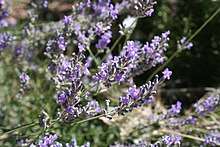 |
Leaves | 130 °C (266 °F) |
| Lemon balm | 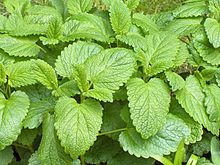 |
Leaves | 142 °C (288 °F) |
| Sage | 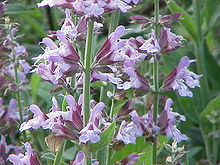 |
Leaves | 190 °C (374 °F) |
| Thyme |  |
Herb | 190 °C (374 °F) |
| Tobacco | 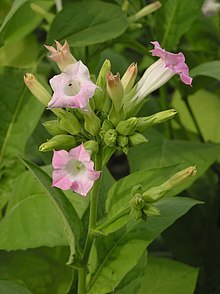 |
Leaf | 140 °C (284 °F)– 200 °C (392 °F)[17] |
See also
References
- ^ Earleywine M, Barnwell SS (2007). "Decreased respiratory symptoms in cannabis users who vaporize". Harm Reduction Journal. 4: 11. doi:10.1186/1477-7517-4-11. PMC 1853086. PMID 17437626.
{{cite journal}}: CS1 maint: unflagged free DOI (link) - ^ "Vaporizers for Medical Marijuana". www.aids.org. Retrieved 2008-07-28.
- ^ Grotenhermen F (2001). "Harm Reduction Associated with Inhalation and Oral Administration of Cannabis and THC". Journal of Cannabis Therapeutics. 1 (3 & 4): 133–152. doi:10.1300/J175v01n03_09.
{{cite journal}}: Unknown parameter|month=ignored (help) - ^ a b Abrams DI, Vizoso HP, Shade SB, Jay C, Kelly ME, Benowitz NL (2007). "Vaporization as a smokeless cannabis delivery system: a pilot study". Clinical Pharmacology and Therapeutics. 82 (5): 572–8. doi:10.1038/sj.clpt.6100200. PMID 17429350.
{{cite journal}}: Unknown parameter|month=ignored (help)CS1 maint: multiple names: authors list (link) - ^ "The Centennial Celebration - Washington, D.C. September 13-17, 1948". Science. 108 (2800): 205–206. 1948. doi:10.1126/science.108.2800.205. PMID 17821306.
{{cite journal}}: Unknown parameter|month=ignored (help) - ^ http://www.chemspider.com/Chemical-Structure.2446.html
- ^ http://www.chemspider.com/Chemical-Structure.2447.html
- ^ http://www.chemspider.com/Chemical-Structure.15266.html
- ^ a b c Gieringer D, St. Laurent J, Goodrich S (2004). "Cannabis Vaporizer Combines Efficient Delivery of THC with Effective Suppression of Pyrolytic Compounds" (PDF). Journal of Cannabis Therapeutics. 4 (1): 7–27. doi:10.1300/J175v04n01_02.
{{cite journal}}: Unknown parameter|month=ignored (help)CS1 maint: multiple names: authors list (link) - ^ a b c d e f g h Hazekamp A, Ruhaak R, Zuurman L, van Gerven J, Verpoorte R (2006). "Evaluation of a vaporizing device (Volcano) for the pulmonary administration of tetrahydrocannabinol". Journal of Pharmaceutical Sciences. 95 (6): 1308–17. doi:10.1002/jps.20574. PMID 16637053.
{{cite journal}}: Unknown parameter|month=ignored (help)CS1 maint: multiple names: authors list (link) - ^ a b Gieringer DH (2001). "Cannabis 'Vaporization'". Journal of Cannabis Therapeutics. 1 (3 & 4): 153–170. doi:10.1300/J175v01n03_10.
{{cite journal}}: Unknown parameter|month=ignored (help) - ^ a b D. Gieringer (1996). "Marijuana Water Pipe and Vaporizer Study". Newsletter of the Multidisciplinary Association for Psychedelic Studies. 6 (3).
{{cite journal}}: Unknown parameter|month=ignored (help) - ^ Zuurman L, Roy C, Schoemaker RC; et al. (2008). "Effect of intrapulmonary tetrahydrocannabinol administration in humans". Journal of Psychopharmacology. 22 (7): 707–16. doi:10.1177/0269881108089581. PMID 18515447.
{{cite journal}}: Explicit use of et al. in:|author=(help); Unknown parameter|month=ignored (help)CS1 maint: multiple names: authors list (link) - ^ a b Alinea restaurant uses Volcano as flavorizer
- ^ Tools for creating aromatic flavors
- ^ Volcano used to release nutmeg aroma
- ^ "All about Vaporizer Gun and Pipes and Temperature". California Chronicle. Retrieved 2008-07-28.
